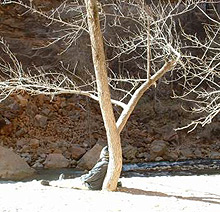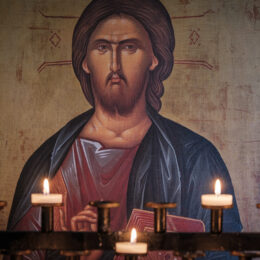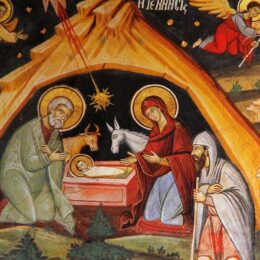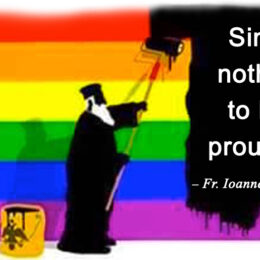 by Fr. Stephen Freeman –
by Fr. Stephen Freeman –
C.S. Lewis, in his marvelous little book, The Great Divorce, uses the imagery of “solidity” versus “ghostliness” to make a distinction between those who have entered paradise, and those who have not. He clearly did not mean to set forth a metaphysical model or to suggest “how things are.” But the imagery is very apt and suggestive when we take a look at what it means for something or someone to exist.
The nature of our secularized worldview is to take all that we see as a presentation of reality and truth. The daily world as we experience it is considered to be the very definition of reality. This is the natural world. Any other perception or presentation of reality is thus supernatural or something other than natural. For those who accept this definition, the onus is on those who suggest that reality is in anyway different than the daily perception of the modern secularized world. To be a “skeptic” is thus not to question everything, but to question everything other than what is perceived as normal and natural.
The Scriptures suggest a different perspective: “for the form of this world is passing away” (1 Cor. 7:31). The world in which we live is not “solid” in the sense of permanence – it is constantly changing and “passing away.”
The same can be said even of our own egos. They vary somewhat from day to day, often tossed about by fears and anxieties, shifting themselves as they encounter the trials of existence.
The Gospel of Christ speaks of a reality that is permanent and of an existence that has something of the same reality. Hebrews offers this description:
“Yet once more I will shake not only the earth but also the heaven.” This phrase, “Yet once more,” indicates the removal of what is shaken, as of what has been made, in order that what cannot be shaken may remain. Therefore let us be grateful for receiving a kingdom that cannot be shaken, and thus let us offer to God acceptable worship, with reverence and awe; for our God is a consuming fire (12:26-29).
St. Paul tells us:
If then you were raised with Christ, seek those things which are above, where Christ is, sitting at the right hand of God. Set your mind on things above, not on things on the earth. For you died, and your life is hidden with Christ in God. When Christ who is our life appears, then you also will appear with Him in glory (Col. 3:1-4).
Our true life – our authentic existence – is not to be found among “the things on the earth.” Our life is something that will appear with Christ when He appears. Of course, this does not restrict our true life to a manifestation at the Second Coming. The Christ who is coming, is also the Christ who is even now “in our midst.” Thus, being in Christ is also the path to our own true existence.
This is perhaps the most difficult aspect of the Christian life. Most often we substitute the ego for our true self – we struggle to learn “to behave” as a Christian. But such efforts only lead us into the world of concepts and arguments, morality and guilt. We do not invent our true self, our authentic existence – it is a new creation and is found only in Christ.
The heart of the spiritual life is not to be found in our efforts to do better or in other lost propositions – the heart of our true life is found precisely in our helplessness and its union with Christ.
St. John the Baptist offers the observation between himself and Christ, “He must increase and I must decrease.” Though this does not mean the disappearance of John, but the fulfillment of John in Christ. In Christ he becomes the Forerunner, the Baptizer and Prophet. He becomes who he was created to be (and prophesied in the Scriptures) and who is ever is in eternity.
Christ must increase and I must decrease. As I decrease so do the false images I cherish of myself. The anxieties that surround me decrease. Lies and deceit decrease for in Christ is only truth. Such a decrease is not the end of my existence but its beginning.
The stories we have in Scripture with regard to a number of characters are marked by this decrease and increase. St. Paul’s transformation (likely preceded by much inner struggle and pain) is one that comes easiest to mind. His decreased is expressed in the image of the Cross: “I am crucified with Christ, nevertheless I live, yet not I but Christ liveth in me…”
“Yet not I.”
The great patriarch Jacob struggles through a lifetime to realize his true self as “Israel,” culminating in his wrestling with the angel. Jacob’s decrease did not result in his annihilation but his fulfillment.
This pattern is repeated again and again in the lives of holy men and women within the pages of Scripture and within the lives of the saints. It is the not only the path to holiness – but also the path to our true humanity.
Learning to live this new existence is the heart of the Christian life. Finding language to describe a new existence is difficult. For lack of a better term, I would describe it as a new mode of existence. Met. John Zizioulas describes this as the ecclesial hypostasis(thus you can see my preference for “mode of existence”). We do not create such a mode or reform ourselves into such a manner of being – it is God’s gift, given to us in Christ. We are baptized into this existence (“raised in the likeness of His resurrection”). For a variety of reasons we often prefer the path of self-creation and reform – always a losing proposition.
And it is precisely at this point (the lost proposition) that the in-breaking of the life of the world to come becomes possible. It is not unlike the helplessness that an alcoholic admits when he says, “I came to find that my life was unmanageable and that only a power greater than myself could help me.” Of course, such moments go more easily than they come.
The heart of the spiritual life is not to be found in our efforts to do better or in other lost propositions – the heart of our true life is found precisely in our helplessness and its union with Christ. The disciplines of fasting, prayer, almsgiving, confession, etc., are not given to us for our improvement, but to bring us back to the moment of helplessness and to keep us as close as possible to that moment at all times.
I believe, O Lord, and I confess, that thou art the Christ, the Son of the living God, who camest into the world to save sinners, of whom I am first.
In such a confession we find the life of the world to come – our own true life.



